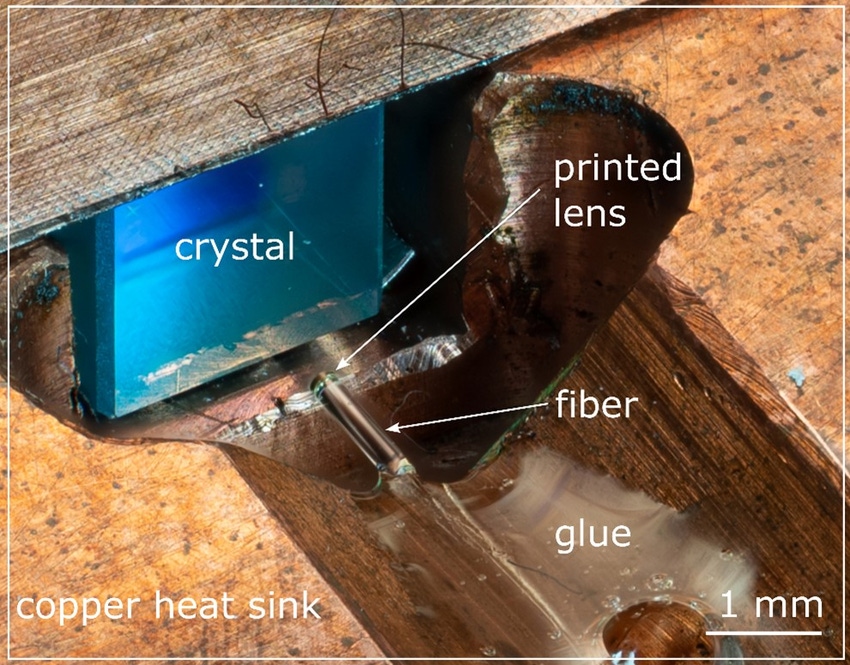Stable Laser Developed with Hybrid Materials Eyed for Self-Driving Cars and More
Medical treatments also could benefit from the new compact lasers, which were fabricated using 3D-printed polymer micro-optics technology.
January 19, 2024

At a Glance
- Researchers 3D printed microscale optics directly onto optical fibers
- A two-photon polymerization 3D printing approach from Nanoscribe was used
- The printed optics were found to be stable, and now the team is looking into their efficiency
Scientists have used 3D-printed polymers in new micro-optics technology that can reduce the size of lasers for use in various new applications, including the lidar systems that enable self-driving car technology and treatments for cancer.
A team of researchers at the University of Stuttgart in Germany have demonstrated 3D-printed polymer-based micro-optics that can withstand the heat and power levels that occur inside a laser. Specifically, they used a 3D printer to fabricate microscale optics directly onto optical fibers in a way that shows a compact combination of fibers and laser crystals inside a single laser oscillator.
This "first implementation of such 3D-printed optics in a real-world laser" shows the optics' tolerance for damage as well as stability for smaller form-factor laser applications, said Simon Angstenberger, the research leader with the 4th Physics Institute at the university, where the work was conducted.
“We significantly reduced the size of a laser by using 3D printing to fabricate high-quality micro-optics directly on glass fibers used inside of lasers,” he explained.
Until now, 3D-printed optics have primarily been used for low-power applications such as endoscopy, but the research paves the way for their use with high-power applications as well. This could be useful in lithography and laser-marking applications such as those used in medical treatments, Angstenberger said.
"We showed that these 3D micro-optics printed onto fibers can be used to focus large amounts of light down to a single point, which could be useful for medical applications such as precisely destroying cancerous tissue," he said.
What They Did With 3D-Printed Optics
The Stuttgart researchers used a 3D-printing approach known as two-photon polymerization� in their work. The technique focuses an infrared laser into a UV-sensitive photoresist, wherein the laser's focal region will absorb two infrared photons simultaneously. This serves to harden the UV resist, the researchers said.
Further, moving the focus around allows various shapes to be created with high precision, making the method well-suited to create miniaturized optics and allow for novel functionalities, such as the creation of free-form optics or complex lens systems, the researchers said.
In their recent work, the researchers used a 3D printer by Nanoscribe to fabricate lenses with a diameter of 0.25 mm and a height of 80 microns onto the end of a fiber with the same diameter. The technique entailed several precise steps that required accuracy, with researchers designing an optical element with commercial software and then placing the fiber into the 3D printer. They then printed a small structure on the end of the fiber.
Once the printing was complete, the team set out to assemble the laser and laser cavity, using fibers to form part of the cavity and thus a hybrid fiber-crystal laser instead of the usual crystal made of costly and bulky mirrors, they said.
Lenses printed at the end of the fibers focus and collect—or couple—the light into and out of the laser crystal. The researchers also glued the fibers into a mount to make the laser system more stable and less susceptible to air turbulence. All told, the crystal and the printed lenses together measured only 5 X 5 centimeters squared, the researchers said.
Surprising Results
Even after achieving these meticulous steps in their research, the team was unsure if the resulting optical structure could function properly with the significant heat and optical power that occurs within a laser cavity, Angstenberger acknowledged.
However, what researchers found after recording the laser power over several hours is that “they are surprisingly stable, and we were not able to observe any kind of damage on the lenses even after several hours of running the laser," he said.
Additionally, the team took scanning electron microscopy images of the optics after they were used in the laser cavity, and these also did not show any visible damage. “Interestingly, we found that the printed optics were more stable than the commercial fiber Bragg grating we used, which ended up limiting our maximum power,” Angstenberger added.
Researchers published a paper on their work in the journal Optics Letters. Their next steps will be to optimize the efficiency of the printed optics, they said.
The team envisions that larger fibers with optimized freeform and aspherical lens designs or a combination of lenses printed directly onto the fiber could help improve the output power. The researchers also would also like to demonstrate different crystals in the laser, which could allow customization of its output for specific applications.
About the Author(s)
You May Also Like



